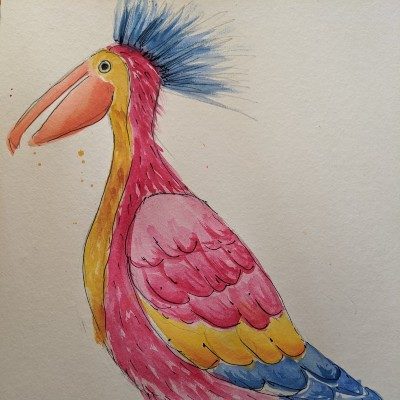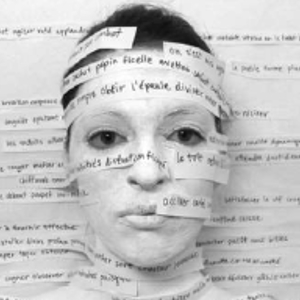Learning Outcomes
Students have fun creating their own bird with various beaks, crests, body shapes and legs. This activity is focused on understanding watercolour techniques too, layering the colours to indicate texture and value.

Process for the Lesson
Step 1: The paper is placed in portrait. Students start by drawing the birds head and unique beak shape in side profile. They can look up references from books/online for the type of head and beak
Step 2: The crest follows next, covering the head but not going out of the paper. Here too, they can research and choose options based on birds crests that are found in real life or even create their own.
Step 3: The birds body is added next. This being the largest part of the drawing, also determines the size of the overall composition to some extent. Space for the legs and feet should be clearly left. The defined feather patterns should be lightly drawn as well.
Step 4: The legs come next. The students can research options for these too based on the functions of the bird’s legs.
Step 5: Students get to choose the colour scheme of their bird too. This one is loosely based on the colours of a macaw. With the colours decided, they fill in their drawing with a light wash of each of the colours. White spaces left between areas is important.
Step 6: Once the first light watercolour wash is dry, a second and third layer is added, with more intense pigment each time. This is a detail shot of what it looks like.
Step 7: This is the overall completed watercolour painting with layers of paint. Different lines within the sections indicate different textures. For example, small strokes within the chest and body. And bigger curved lines within the wing feathers.
Step 8: The final step is using either a black gel pen or black sketch pen to define some areas of the bird.
Step 2: The crest follows next, covering the head but not going out of the paper. Here too, they can research and choose options based on birds crests that are found in real life or even create their own.
Step 3: The birds body is added next. This being the largest part of the drawing, also determines the size of the overall composition to some extent. Space for the legs and feet should be clearly left. The defined feather patterns should be lightly drawn as well.
Step 4: The legs come next. The students can research options for these too based on the functions of the bird’s legs.
Step 5: Students get to choose the colour scheme of their bird too. This one is loosely based on the colours of a macaw. With the colours decided, they fill in their drawing with a light wash of each of the colours. White spaces left between areas is important.
Step 6: Once the first light watercolour wash is dry, a second and third layer is added, with more intense pigment each time. This is a detail shot of what it looks like.
Step 7: This is the overall completed watercolour painting with layers of paint. Different lines within the sections indicate different textures. For example, small strokes within the chest and body. And bigger curved lines within the wing feathers.
Step 8: The final step is using either a black gel pen or black sketch pen to define some areas of the bird.
What to Watch out for
The students should decide whether their bird is going to be in portrait or in landscape. At this stage they don’t know what the final bird is going to look like, but should generally decide the orientation, whether more long or wide. Referencing real birds can help them understand, for example flamingos for long form and ducks for wide form.
Students should start their drawing at the top of the paper to use the space well. When doing the first step though, they should also account for space above the birds head within which the crest will be drawn.
With each step, they should check the proportion of the parts in relation to the whole. For example, the feet should not be so small that they appear to not be able to support the body shape drawn. In that sense, realistic proportion is important, although they are creating their own combination of parts.
When drawing the body, they should ensure that they leave space for the legs below.
When painting the watercolour wash, the students should paint parts that are disconnected to avoid colours bleeding into each other. The remaining parts can be filled in when the initially painted sections are dry.
The black sketch pen line is not meant to be a complete outline of the work. Small sections of each curved line are enough.
Avoid making sketch pen lines in the body of the bird since it will look like hair.
Students should start their drawing at the top of the paper to use the space well. When doing the first step though, they should also account for space above the birds head within which the crest will be drawn.
With each step, they should check the proportion of the parts in relation to the whole. For example, the feet should not be so small that they appear to not be able to support the body shape drawn. In that sense, realistic proportion is important, although they are creating their own combination of parts.
When drawing the body, they should ensure that they leave space for the legs below.
When painting the watercolour wash, the students should paint parts that are disconnected to avoid colours bleeding into each other. The remaining parts can be filled in when the initially painted sections are dry.
The black sketch pen line is not meant to be a complete outline of the work. Small sections of each curved line are enough.
Avoid making sketch pen lines in the body of the bird since it will look like hair.








